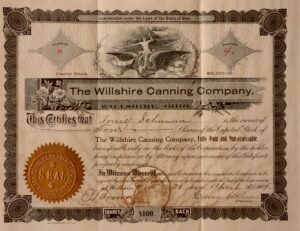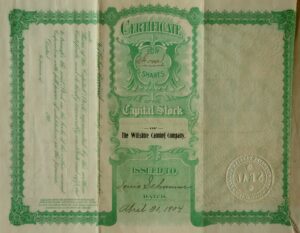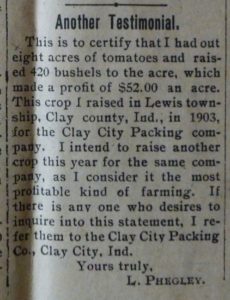Willshire had a canning company in the early 1900s, appropriately named The Willshire Canning Company. I do not know a lot about the company or where it was located, just what I have read in a couple sources, The Willshire Herald and Dun and Bradstreet.
But a recent find shows that my great-grandfather Louis J. Schumm was a shareholder in The Willshire Canning Company. He purchased 4 shares of The Willshire Canning Company stock at $100 a share, issued 30 April 1904, signed by secretary E. Brown and president Henry Altheon. Louis’ stock certificate was number 8, obviously a very early number.

Willshire Canning Co stock certificate, 1904, Louis J Schumm

Willshire Canning Co stock certificate, 1904, Louis J Schumm
The Willshire Canning Company likely began about that time, early 1904. The 5 May 1904 edition of The Willshire Herald mentions The Willshire Canning Company several times and encouraged farmers to grow tomatoes and sweet corn for the company.
Articles from the 5 May 1904 Willshire Herald about the canning company:
The Willshire Canning factory now has over 150 acres of sweet corn and tomatoes contracted. Better get into the band wagon while there is yet a chance to toot a lead horn.
And,
Farmers, Attention!
All persons desiring to avail themselves of the opportunity to raise sweet corn or tomatoes for the Canning Factory for the coming season, can contract with the processor, Chas. Nachbauer, on or after March 10, at the Hardware Store of Hurless & Brown, Willshire, O.
Professor Catchpole is going to put in his summer vacation superintending and caring for fifteen acres of corn and tomatoes, for the Canning Factory. How much better such a course is than to sit around like a bump on a log and croak against the Canning Factory and its success, as a number of our citizens are doing.
Testimonials from the same paper, letters written to the canning factory’s processor, Chas. Nachbauer:
Another Testimonial
This is to certify that I had out eight acres of tomatoes and raised 420 bushels to the acre, which made a profit of $52.00 an acre. This crop I raised in Lewis township, Clay County, Ind., in 1903, for the Clay City Packing company. I intend to raise another crop this year for the same company, as I consider it the most profitable kind of farming. If there is anyone who desires to inquire into this statement, I refer them to the Clay City Packing Co., Clay City, Ind. Yours truly, L. Phegley.

Willshire Herald, 1904
DOES IT PAY?
Read this statement from men who have raised material for canning factories and then ask yourselves this question: DOES IT PAY NOT to RAISE VEGETABLES for the CANNING FACTORY WHEN YOU HAVE THE OPPORTUNITY? Following is the statement of one of them:
Clay City, Ind., April 19, 1904.
“We made a little over One Hundred dollars an acre off our tomatoes. So, you see, it paid us well for raising them. There are a number of others here who did as well. I will give you a few names of farmers around here who say that it paid them to raise tomatoes for the factory. Wm. Liechty, George Williamson, Robert McKee, Mr. Phegley
And there are many others who would willingly add their testimony, but I think that it is not necessary to mention the names of others. Yours truly, J.P. Scherb, Clay City, Ind.
C.E. Detter is now at Oklahoma City, working up a $15,000 canning factory proposition. He says that city is a hustling, bustling place. [1]
The Willshire Canning Company was first listed in Dun and Bradstreet March 1905 and was in each consecutive issue through 1913, with a consistent H 3½ rating. In 1914 Dun and Bradstreet lists The Willshire Packing Company but not the canning company. I do not know if the packing company replaced the canning company or if the two companies were unrelated. By 1920 The Willshire Packing Company was not listed either. [2]

Dun & Bradstreet, Mar 1905, part 2, p.113
I wonder if my great-grandfather Louis Schumm raised vegetables for the factory?
[1] The Willshire Herald, Willshire, Ohio, 5 May 1904.
[2] Dun & Bradstreet Reference Book, Library of Congress, www.loc.gov. Vol. 2 of the following issues: Mar 1905:113 [image 197/587]; Jul 1906:116 [image 207/618]; Mar 1907:118 [image 204/629]; Mar 1908:120 [image 248/692]; Mar 1913:119 [image 210/618]; Sep 1920:142-4 [image 198-9/854].



2 comments
Karen, a Willshire Herald article that detailed “Happenings of 1915” noted that Willshire’s canning factory was totally destroyed by fire in that year for a total loss of about $10,000.
It was a bad year for fires as “On New Year’ s Eve, 1915 Willshire was darkened by one of the most disastrous fires of its history. A half block of old frame buildings were destroyed on State Street from Cully’s Hardware to the Rex Hardware. (Quoted from the same Willshire Herald article.)
Author
Thank you for that good information, Sondra. That coincides with the Dun and Bradstreet information. That sounds like it was a disastrous fire. Thanks for writing.